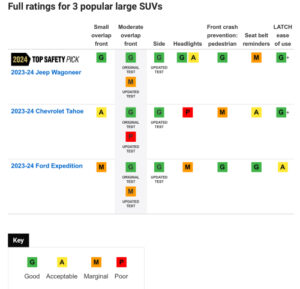Recent ratings from the Insurance Institute for Highway Safety (IIHS), an American educational non-profit, indicate that large SUVs may not be as safe as their size suggests.
Among three popular large SUVs tested, only the Jeep Wagoneer qualified for a 2024 Top Safety Pick award. The Chevrolet Tahoe and Ford Expedition did not meet the criteria, mainly due to poor performance in the small overlap front crash test. Since 2021, more than 90% of new models have received good ratings in this evaluation.
These large SUVs are designed for transporting people and towing boats and campers, but they fall short in providing adequate protection for back seat passengers. This shortfall prevented the Wagoneer from achieving the higher-tier Top Safety Pick+ award.
The small overlap front crash test posed significant challenges for all three vehicles, though the Wagoneer performed the best. The good-rated Wagoneer maintained survival space for the driver and front passenger during the test. However, slight intrusion in the footwell posed a moderate risk of injury to the driver’s left foot and ankle. The front and side curtain airbags functioned properly, preventing the dummies’ heads from nearing the vehicle’s structures.
The acceptable-rated Tahoe showed adequate survival space for the driver, with effective airbags and restraints. However, significant intrusion into the footwell indicated a substantial risk of lower leg injuries. The passenger-side test revealed extensive footwell intrusion, contributing to a high risk of injury to the right foot and moderate risk to the left leg of the passenger.
The marginal-rated Expedition’s structure did not hold up well in tests on either side. The driver-side test showed the steering column partially detaching from the instrument panel and the A-pillar separating from the rocker panel. Excessive footwell intrusion indicated a high risk of injury to the driver’s right leg and moderate risk to the left. Similar footwell intrusion was observed in the passenger-side test.
All three vehicles earned good ratings in the original moderate overlap front evaluation, which assesses front seat protection. None of the vehicles allowed substantial intrusion into the driver’s survival space. However, the Wagoneer driver dummy’s head hit the steering wheel through the airbag, and the Expedition’s side curtain airbag did not deploy.

“The huge mass of these large SUVs provides some additional protection in crashes with smaller vehicles, though that also means they present more danger to other road users. The flip side of their large size is that there is a lot more force to manage when they crash into a fixed obstacle like a tree or bridge abutment or the barrier we use in our front crash tests,” explained IIHS president David Harkey.
Updated moderate overlap ratings, including restraint performance and injury risk for a second-row passenger, showed that none of the vehicles performed well. Measurements from the rear dummy indicated a high risk of chest injuries due to high seat belt forces. Only the Expedition has second-row belt pretensioners, but its injury metrics were comparable to those of the other two SUVs. The Expedition’s side curtain airbag for the rear passenger also failed to deploy.
The Tahoe’s poor rating stemmed from high risks of head, neck, and chest injuries, with the second-row lap belt sliding onto the rear dummy’s abdomen, increasing the risk of abdominal injuries.
All three SUVs achieved good ratings in the updated side test, although the rear dummy’s head hit the side curtain airbag hard in the Expedition.
In the pedestrian crash avoidance evaluation, the Expedition and Wagoneer received good ratings for their standard front crash prevention systems. Both vehicles avoided collisions with the pedestrian dummy in most daytime and night-time scenarios. The Wagoneer’s headlights were rated acceptable or good, while the Expedition’s headlights received a marginal rating due to poor road illumination on curves and excessive glare.
The Tahoe earned a marginal rating in the pedestrian test, performing well in daylight but poorly in night-time scenarios. The vehicle’s standard system struggled to slow down adequately in low-light conditions, partly due to poor-rated headlights.
Effective headlights and pedestrian crash avoidance systems are crucial for larger vehicles, as their height and weight pose greater risks to pedestrians. The Expedition’s seat belt reminders earned a good rating, while the Tahoe’s were rated acceptable and the Wagoneer’s marginal. Both the Wagoneer and Tahoe earned good+ ratings for their LATCH systems, designed to simplify child seat installation, while the Expedition received an acceptable rating.
“These discouraging results show that some popular vehicles still lag behind in meeting the most advanced safety standards. The good news is that the top performer in this class proves that auto makers can readily address these problems,” added Raul Arbelaez, vice president of the Institute’s Vehicle Research Center.

